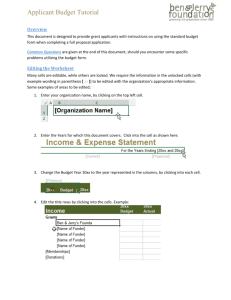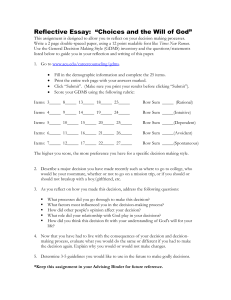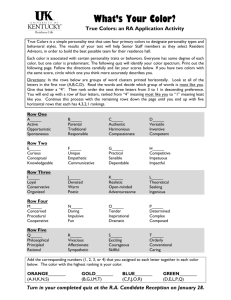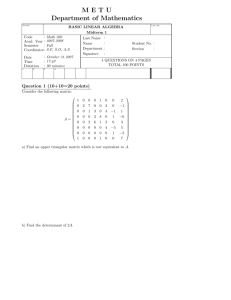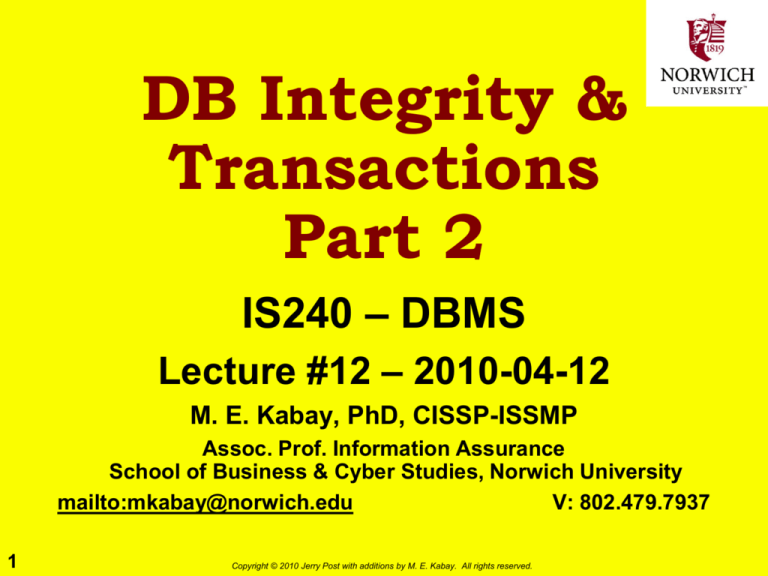
DB Integrity &
Transactions
Part 2
IS240 – DBMS
Lecture #12 – 2010-04-12
M. E. Kabay, PhD, CISSP-ISSMP
Assoc. Prof. Information Assurance
School of Business & Cyber Studies, Norwich University
mailto:mkabay@norwich.edu
V: 802.479.7937
1
Copyright © 2010 Jerry Post with additions by M. E. Kabay. All rights reserved.
Objectives
Define elements of ACID transactions
Atomicity
Consistency
Isolation
Durability
Define SQL Isolation Levels
What are phantom rows and how do we avoid
them?
How are internal key values generated and
used in updates in the face of concurrency?
What is the purpose of database cursors?
2
Copyright © 2010 Jerry Post with additions by M. E. Kabay. All rights reserved.
Topics
ACID Transactions
SQL 99/2003 Isolation Levels
Phantom Rows
Generated Keys
Database Cursors
Sally’s Pet Store Inventory
3
Copyright © 2010 Jerry Post with additions by M. E. Kabay. All rights reserved.
ACID Transactions
Atomicity: all changes succeed or fail
together.
Consistency: all data remain internally
consistent (when committed) and can be
validated by application checks.
Isolation: The system gives each transaction
the perception that it is running in isolation.
There are no concurrent access issues.
Durability: When a transaction is committed,
all changes are permanently saved even if
there is a hardware or system failure.
4
Copyright © 2010 Jerry Post with additions by M. E. Kabay. All rights reserved.
SQL 99/2003 Isolation
Levels
READ UNCOMMITTED
Problem: might read dirty data that is rolled back
Restriction: not allowed to save any data
READ COMMITTED
Problem: Second transaction might change or delete
data
Restriction: Need optimistic concurrency handling
REPEATABLE READ
Problem: Phantom rows caused by concurrent access
SERIALIZABLE
Provides same level of control as if all transactions were
run sequentially.
But, still might encounter locks and deadlocks
Remember to LOCK in SAME ORDER and UNLOCK
in REVERSE ORDER!
5
Copyright © 2010 Jerry Post with additions by M. E. Kabay. All rights reserved.
Phantom Rows
ALICE
SELECT SUM(QOH)
FROM Inventory
WHERE Price BETWEEN 10 and 20
Result: 5 + 4 + 8 = 17
Included
in first
query
6
ItemID
111
113
117
118
119
120
121
QOH
Price
5
15
6
7
12
30
4
12
7
22
8
17
7
16
122
3
14
BOB
INSERT INTO Inventory
VALUES (121, 7, 16)
INSERT INTO Inventory
VALUES (122, 3, 14)
ALICE
Additional or changed
rows will be included in
the second query,
which may cause
contradictions in results
SELECT SUM(QOH)
FROM Inventory
WHERE Price BETWEEN 10 and 20
Result: 5 + 4 + 8 + 7 + 3 = 27
Copyright © 2010 Jerry Post with additions by M. E. Kabay. All rights reserved.
Generated Keys
Customer Table
Create an order for a new customer:
CustomerID, Name, …
(1) Create new key for CustomerID
(2) INSERT row into Customer
(3) Create key for new OrderID
(4) INSERT row into Order
Order Table
OrderID, CustomerID, …
Problem: What if someone concurrently generates another autokey
just as you are trying to use the one you created?
Generally the DBMS remembers only the latest autokey!
7
Copyright © 2010 Jerry Post with additions by M. E. Kabay. All rights reserved.
Methods to Generate Keys
1. The DBMS generates key values automatically
whenever a row is inserted into a table.
Drawback: it is tricky to get the generated
value to use it in a second table.
2. A separate key generator is called by a
programmer to create a new key for a specified
table.
Drawback: programmers have to write code
to generate a key for every table and each
row insertion.
Overall drawbacks: neither method is likely
to be transportable. If you change the DBMS,
you will have to rewrite the procedures to
generate keys.
8
Copyright © 2010 Jerry Post with additions by M. E. Kabay. All rights reserved.
Auto-Generated Keys
9
Create an order for a new customer:
1. INSERT row into Customer
2. Get the key value that was generated
3. Verify the key value is correct. How?
4. INSERT row into Order
Major problem:
Step 2 requires that the DBMS return the key
value that was most recently generated.
How do you know it is the right value?
What happens if two transactions generate keys
at almost the same time on the same table?
Copyright © 2010 Jerry Post with additions by M. E. Kabay. All rights reserved.
Key-Generation Routine
Create an order for a new customer:
Generate a key for CustomerID
INSERT row into Customer
Generate a key for OrderID
INSERT row into Order
This method ensures that unique keys are
generated
You can use the keys in multiple tables
because you know the value
But none of it is automatic
Always requires procedures and
sometimes data triggers
10
Copyright © 2010 Jerry Post with additions by M. E. Kabay. All rights reserved.
Topics
ACID Transactions
SQL 99/2003 Isolation Levels
Phantom Rows
Generated Keys
Database Cursors
Sally’s Pet Store Inventory
11
Copyright © 2010 Jerry Post with additions by M. E. Kabay. All rights reserved.
Database Cursors
Year
1998
1999
2000
2001
Purpose
Track through table or
query one row at a time.
Data cursor is a pointer to active
row.
Why?
Performance.
SQL cannot do everything.
Complex calculations.
Compare multiple rows.
12
Copyright © 2010 Jerry Post with additions by M. E. Kabay. All rights reserved.
Sales
104,321
145,998
276,004
362,736
Database Cursor Program
Structure
DECLARE cursor1 CURSOR FOR
SELECT AccountBalance
FROM Customer;
sumAccount, balance Currency;
SQLSTATE Char(5);
BEGIN
sumAccount = 0;
OPEN cursor1;
WHILE (SQLSTATE = ‘00000’)
BEGIN
FETCH cursor1 INTO balance;
IF (SQLSTATE = ‘00000’) THEN
sumAccount = sumAccount + balance;
END IF
END
CLOSE cursor1;
-- display the sumAccount or do a calculation
END
13
Copyright © 2010 Jerry Post with additions by M. E. Kabay. All rights reserved.
Cursor Positioning with
FETCH
DECLARE cursor2 SCROLL CURSOR FOR
SELECT …
OPEN cursor2;
FETCH LAST FROM cursor2 INTO …
Loop…
FETCH PRIOR FROM cursor2 INTO …
End loop
CLOSE cursor2;
FETCH positioning options:
FETCH NEXT
next row
FETCH PRIOR
prior row
FETCH FIRST
first row
FETCH LAST
last row
FETCH ABSOLUTE 5
fifth row
FETCH RELATIVE -3
back 3 rows
14
Copyright © 2010 Jerry Post with additions by M. E. Kabay. All rights reserved.
Problems with Multiple
Users
Original Data
Modified Data
Name
Alice
Carl
Donna
Ed
Name
Alice
Bob
Carl
Donna
Ed
Sales
444,321
254,998
652,004
411,736
New row is
added--while
code is running.
Sales
444,321
333,229
254,998
652,004
411,736
The SQL standard can prevent this problem with the
INSENSITIVE option:
DECLARE cursor3 INSENSITIVE CURSOR FOR …
But this is an expensive approach because the
DBMS usually makes a copy of the data.
Instead, avoid moving backwards.
15
Copyright © 2010 Jerry Post with additions by M. E. Kabay. All rights reserved.
Changing Data with Cursors
DECLARE cursor1 CURSOR FOR
SELECT Year, Sales, Gain
Year
Sales
FROM SalesTotal
2000
151,039
ORDER BY Year
2001
179,332
FOR UPDATE OF Gain;
2002
195,453
priorSales, curYear, curSales, curGain
BEGIN
2003
221,883
priorSales = 0;
2004
223,748
OPEN cursor1;
Loop:
FETCH cursor1 INTO curYear, curSales, curGain
UPDATE SalesTotal
SET Gain = Sales – priorSales
WHERE CURRENT OF cursor1;
priorSales = curSales;
Until end of rows
CLOSE cursor1;
COMMIT;
END
16
Copyright © 2010 Jerry Post with additions by M. E. Kabay. All rights reserved.
Gain
Sally’s Pet Store Inventory
Inventory method 1: calculate the current
quantity on hand by totaling all purchases
and sales every time the total is needed.
Drawback: performance
Inventory method 2: keep a running balance
in the inventory table and update it when an
item is purchased or sold.
Drawback: tricky code
Also, you need an adjustment process for
“inventory shrink”
Corrections of mistakes
17
Copyright © 2010 Jerry Post with additions by M. E. Kabay. All rights reserved.
Inventory QuantityOnHand
Merchandise
ItemID
Description
QuantityOnHand
ListPrice
Category
Add items purchased
Subtract items sold
Adjust for shrink
SaleItem
SaleID
ItemID
Quantity
SalePrice
18
Copyright © 2010 Jerry Post with additions by M. E. Kabay. All rights reserved.
Inventory Events
SaleItem
SaleID
ItemID
Quantity
SalePrice
A USER MAY
19
•
Add a row.
•
Delete a row.
•
Update Quantity.
•
Update ItemID.
For a new sale, a row is added
to the SaleItem table.
A sale or an item could be
removed because of a clerical
error or the customer changes
his or her mind. A SaleItem row
will be deleted.
An item could be returned, or
the quantity could be adjusted
because of a counting error.
The Quantity is updated in the
SaleItem table.
An item is entered incorrectly.
ItemID is updated in the
SaleItem table.
Copyright © 2010 Jerry Post with additions by M. E. Kabay. All rights reserved.
New Sale: Insert SaleItem
Row
CREATE TRIGGER NewSaleItem
AFTER INSERT ON SaleItem
REFERENCING NEW ROW AS newrow
FOR EACH ROW
UPDATE Merchandise
SET QuantityOnHand = QuantityOnHand – newrow.Quantity
WHERE ItemID = newrow.ItemID;
20
Copyright © 2010 Jerry Post with additions by M. E. Kabay. All rights reserved.
Delete SaleItem Row
CREATE TRIGGER DeleteSaleItem
AFTER DELETE ON SaleItem
REFERENCING
OLD ROW AS oldrow
FOR EACH ROW
UPDATE Merchandise
SET QuantityOnHand =
QuantityOnHand + oldrow.Quantity
WHERE ItemID = oldrow.ItemID;
21
Copyright © 2010 Jerry Post with additions by M. E. Kabay. All rights reserved.
Inventory Update Sequence
SaleItem
SaleID 101
ItemID
15
Quantity 10
Quantity
8
Clerk
1.
Enter new sale
item, enter
Quantity of 10.
3. Change Quantity
to 8.
Event Code
Merchandise
ItemID
QOH
15
50
QOH
40
QOH
32
ItemID
QOH
15
50
QOH
40
4. Add original
QOH
Quantity 10 back
and subtract
Quantity 8 from
QOH.
42
2. Subtract Quantity
10 from QOH.
4. Subtract Quantity
8 from QOH.
Solution that corrects for change
SaleID 101
ItemID
15
Quantity 10
Quantity
22
8
1.
Enter new sale
item, enter
Quantity of 10.
3. Change Quantity
to 8.
2. Subtract Quantity
10 from QOH.
Copyright © 2010 Jerry Post with additions by M. E. Kabay. All rights reserved.
OOPS
Quantity Changed Event
CREATE TRIGGER UpdateSaleItem
AFTER UPDATE ON SaleItem
REFERENCING
OLD ROW AS oldrow
NEW ROW AS newrow
FOR EACH ROW
UPDATE Merchandise
SET QuantityOnHand =
QuantityOnHand
+ oldrow.Quantity
– newrow.Quantity
WHERE ItemID = oldrow.ItemID;
23
Copyright © 2010 Jerry Post with additions by M. E. Kabay. All rights reserved.
ItemID or Quantity Changed
Event
CREATE TRIGGER UpdateSaleItem
AFTER UPDATE ON SaleItem
REFERENCING OLD ROW AS oldrow
NEW ROW AS newrow
FOR EACH ROW
BEGIN
UPDATE Merchandise
SET QuantityOnHand = QuantityOnHand + oldRow.Quantity
WHERE ItemID = oldrow.ItemID;
UPDATE Merchandise
SET QuantityOnHand = QuantityOnHand – newRow.Quantity
WHERE ItemID = newrow.ItemID;
COMMIT;
END
24
Copyright © 2010 Jerry Post with additions by M. E. Kabay. All rights reserved.
DISCUSSION
25
Copyright © 2010 Jerry Post with additions by M. E. Kabay. All rights reserved.


